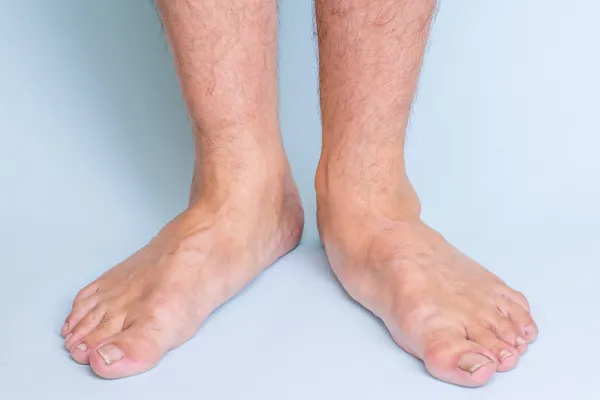Tips & Advice From West Haven Foot and Ankle Center

Flat Feet and Arch Pain: What You Should Know
Have you ever noticed your feet seeming to collapse inward when you stand or walk? You might be one of the many people dealing with flat feet—a condition where the arches on the inside of your feet are lower than normal or completely absent. While some people live with flat feet pain-free, others experience chronic arch pain, fatigue in their legs, or even issues that extend into their knees, hips, and back.
In this blog, we’ll break down what flat feet really are, how they impact your posture and gait, and what you can do to manage or relieve discomfort before it leads to long-term complications.
What Are Flat Feet?
Flat feet, also known as fallen arches, occur when the arch of the foot doesn’t form correctly or collapses over time. While some people are born with flat feet (a condition known as congenital flatfoot), others may develop it in adulthood due to injury, aging, weight gain, or medical conditions like arthritis or diabetes.
You can check yourself at home by doing the “wet footprint test”: Wet your feet, step onto a dry surface, and examine the footprint. If the entire sole of your foot is visible without a curve where the arch should be, it’s likely that you have flat feet.
How Flat Feet Affect Posture and Walking
Your foot arch plays a critical role in weight distribution and shock absorption when you move. When the arch collapses, the alignment of your entire lower body can be thrown off.
Here’s how flat feet affect your posture and movement:
Overpronation: Flat feet often cause the ankles to roll inward when walking or running (a condition called overpronation). This puts excess strain on the ankles, knees, and hips.
Poor posture: Without proper support from the arches, your body tries to compensate. This leads to a forward-leaning posture and increased stress on the lower back.
Gait problems: People with flat feet often have an altered walking pattern, which can lead to muscle fatigue, joint pain, and increased risk of injuries, especially in the shins and knees.
Signs You May Need Help for Flat Feet
While some individuals with flat feet experience no discomfort, others struggle with:
Pain in the arches or heels
Swelling on the inside of the ankle
Pain that worsens with activity
Back, hip, or knee pain without a clear cause
Shoes wearing out unevenly
If you’re experiencing any of these, it’s a good idea to get evaluated by a podiatrist.
Treatment Options for Flat Feet and Arch Pain
The good news is, there are many non-surgical treatment options to help support your arches and relieve pain:
1. Custom Orthotics
One of the most effective ways to manage flat feet is by using custom orthotics, which are inserts designed specifically for your foot structure. They help restore proper alignment and reduce stress on your joints.
2. Supportive Footwear
Ditch the flip-flops and flimsy flats—supportive shoes with proper arch support and cushioning can make a huge difference in daily comfort.
3. Stretching and Strengthening Exercises
Certain exercises can help strengthen the muscles around your arches and ankles, improving overall foot mechanics. Calf stretches, towel scrunches, and rolling a tennis ball under your foot are great places to start.
4. Physical Therapy
A trained therapist can guide you through targeted stretches and gait retraining techniques to improve alignment and reduce pain.
5. Weight Management
Excess body weight adds more pressure to the arches. Even modest weight loss can significantly reduce symptoms.
6. Surgery (in rare cases)
For severe flatfoot or cases that don’t respond to conservative treatments, surgery may be considered to correct structural abnormalities.
Long-Term Outlook
Left untreated, flat feet can lead to chronic pain, reduced mobility, and an increased risk of injuries. However, with early intervention and a treatment plan tailored to your needs, you can stay active and pain-free for the long haul.
When to See a Podiatrist
If your feet hurt, your shoes wear unevenly, or you’ve noticed changes in the way you walk, it’s time to get checked out. At West Haven Foot and Ankle, we offer comprehensive foot evaluations, custom orthotic fittings, and treatment plans designed to keep you moving comfortably.
Final Thoughts
Flat feet are common—but that doesn’t mean you have to live with discomfort. Whether you’re on your feet all day for work or just want to enjoy your weekend walks without pain, addressing arch issues can improve your entire body’s alignment and quality of life.
Ask West Haven Foot and Ankle Center And Their Team
Fill in the form to request a call from our team. One of our team members will call you for FREE and answer any questions or concerns you may have about your condition
Where To Find West Haven Foot and Ankle Center

If you have any questions before scheduling an appointment or for general inquiries, please use the contact us button below. Our team will promptly reach out to assist you.
Opening Hours
Monday: 8am - 5pm
Tuesday: 8am - 5pm
Wednesday: Closed
Thursday: 8am - 5pm
Friday: 8am - 5pm
Saturday: Closed
Sunday: Closed

